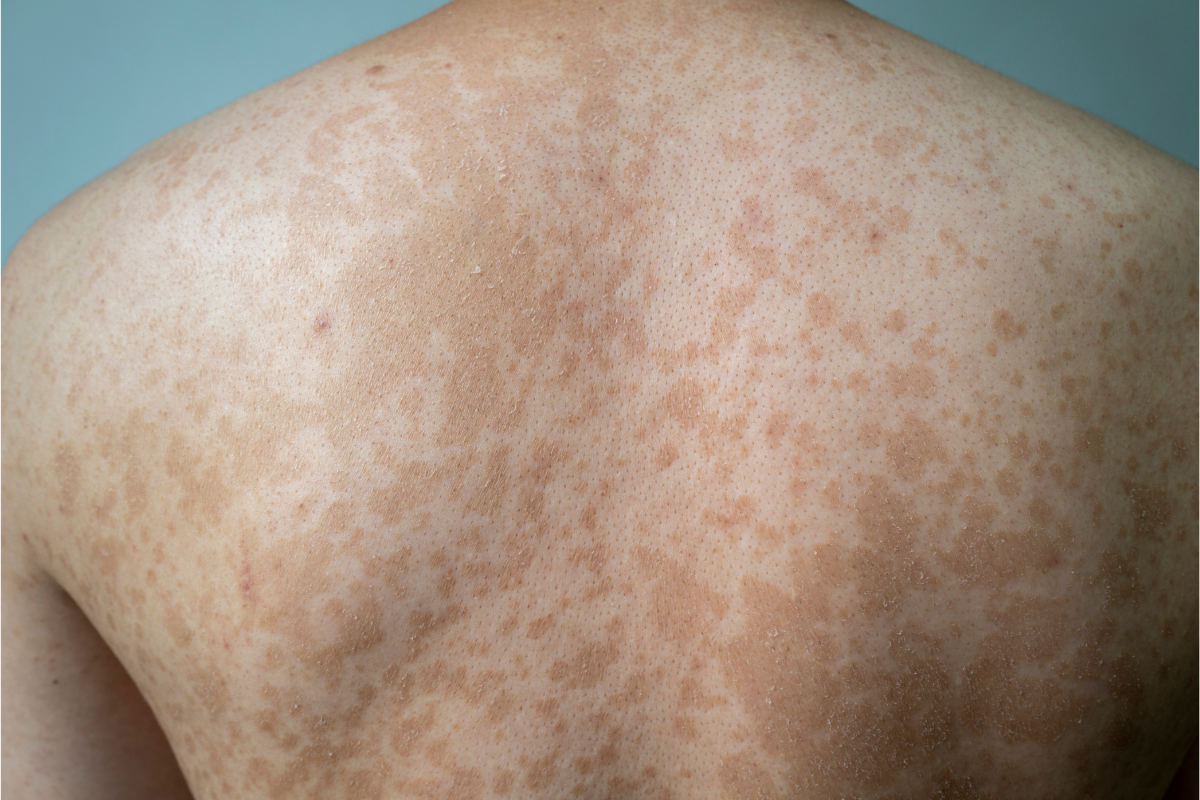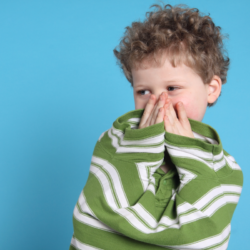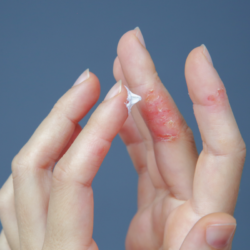Have you ever woken up one morning, looked in the mirror and noticed unusual spots on your skin? Don’t panic! You could be dealing with a condition that’s more common than you think: Pityriasis versicolor. Although the name may sound like something out of an old potion book, this condition is actually a fungal infection of the skin that is completely manageable – and naturally so. In this article, we’ll explore some gentle but effective ways to say goodbye to those pesky spots. Are you ready? Let’s dive into the fascinating world of natural remedies.
What is Pityriasis versicolor?
Before venturing into treatments, let’s get to know our enemy. Pityriasis versicolor is a superficial fungal infection of the skin caused by the proliferation of a yeast called Malassezia (also responsible for dandruff or seborrhoeic dermatitis, for example). Although this micro-organism is a regular resident of our skin, certain conditions can encourage its excessive growth, leading to the appearance of spots.
Pityriasis Versicolor is a superficial skin condition, distinguished by its non-contagious nature and its manifestation in coloured macules mainly located on the trunk. This dermatological condition, resulting from the proliferation of a fungus called Pityrosporum, affects a significant proportion of the population, sparking growing interest in therapeutic solutions that are both effective and respect the natural balance of the epidermis.
Symptoms of Pityriasis Versicolor
This mycosis is characterised by the appearance of scaly lesions and pigmentation spots, lighter or darker than the natural skin tone, mainly on the chest and back. These spots, the result of fungal activity, are prone to scaling and, without intervention, can spread in size and area, sometimes reaching the thighs and arms. Hormonal imbalances, genetic predisposition and hot, humid environments are known to be catalysts for this condition.
The tell-tale signs of Pityriasis versicolor include discoloured patches – often white, pink or brown – which may appear on the chest, back, shoulders and, in some cases, neck. These spots may be accompanied by a slight desquamation, creating a “peeling skin” appearance. These marks, which are often more noticeable after exposure to the sun, are the result of an imbalance in the skin flora that encourages the multiplication of Pityrosporum.
Causes and risk factors
High humidity, heat, perspiration and a weakened immune system can create the perfect breeding ground for Malassezia. The good news? Knowing these factors gives us valuable clues as to how to prevent and treat the condition naturally.
Relieving Pityriasis Versicolor with homeopathy
Pityriasis Versicolor, a skin condition that looks benign but can damage the appearance and health of the skin over the long term, finds a gentle yet effective therapeutic response in homeopathy. This skin mycosis, which prefers to thrive on areas rich in sebaceous glands such as the trunk, abdomen or roots of the limbs, is caused by the proliferation of specific fungi such as Malassezia furfur or Pityrosporum. Both men and women, particularly young adults, are susceptible to this condition, which makes no distinction between the sexes.
Homeopathy to help Pityriasis Versicolor
Homeopathy, renowned for its individualised approach and its ability to stimulate the body’s natural healing mechanisms, offers specific remedies for Pityriasis Versicolor. This therapeutic method focuses on the individual as a whole, aiming to rebalance the body so that it can defend itself effectively against the factors that encourage fungal proliferation.
Relevant homeopathic remedies
- Selenium Boiron: Indicated for skin with excessive scaling, this remedy may be particularly useful for cases of Pityriasis Versicolor characterised by pronounced scaly patches.
- Sulfur Boiron: Recommended for skin prone to itching and aggravation by heat, Sulfur can help relieve symptoms and prevent recurrences.
- Graphites Boiron: Suitable for dry skin with eczema tendencies, Graphites may be beneficial for people with scaly, itchy lesions.
Prevention of Pityriasis versicolor and additional advice
In addition to homeopathic treatment, it is advisable to adopt a healthy lifestyle and skincare routine to minimise the risk of recurrence. This includes maintaining rigorous personal hygiene, using gentle skin care products, and avoiding triggers such as excessively hot and humid environments.
Combined antifungal and homeopathic treatment
Pityriasis Versicolor, a common dermatological condition, is characterised by the appearance of discrete patches on the skin resulting from fungal overgrowth. Fortunately, a range of effective antifungal treatments are available to control and eradicate this condition.
Ketoconazole-based shampoo
Treatment often begins with the application of an antifungal shampoo containing ketoconazole, renowned for its effectiveness against the fungi responsible for pityriasis versicolor. This approach directly targets the affected areas, limiting fungal proliferation.
Complementary homeopathy
Homeopathy adds an extra dimension to the treatment with Arsenicum Iodatum and Arsenicum Album, prescribed as 5 CH granules, and Sepia Officinalis 7 CH, to be taken morning and evening. These remedies aim to balance the internal imbalances that can favour conditions conducive to fungal growth.
Berberis Vulgaris is sometimes recommended as a supplement for its depurative properties, which can help in the fight against skin infections.
Lehning homeopathic complex based on Sulfur
Available in pharmacies, Sulfur Lehning Complex No. 12 combines Arsenicum Album at 4 DH and Sulfur at 3 DH, to be taken twice a day to actively combat pityriasis versicolor.
Melaleuca alternifolia essential oil
Local application of Tea Tree (Melaleuca alternifolia) essential oil is also recommended for its natural antifungal properties, offering targeted treatment of the affected areas. Tea tree oil is a powerful antifungal agent. Applied topically, it can help to significantly reduce the proliferation of Malassezia. Mix a few drops with a carrier oil, such as sweet almond oil, and dab gently onto the affected areas.
Lavandula officinalis essential oil
As well as its soothing scent, lavender oil has antifungal properties. It can be used in the same way as tea tree oil to soothe the skin.
Topical treatment and precautions for Pityriasis versicolor
Imidazole lotion or shampoo, applied twice a day for three weeks, is a first line of defence as soon as symptoms appear. For large areas, including the scalp, Ketoderm gel in a single weekly dose is suggested. Selenium sulphide is a viable alternative, with three weekly applications over a three-week period.
Important: Sun exposure should be avoided during treatment, as it can lead to the formation of white patches on previously affected areas.
When should you consult a dermatologist?
If symptoms persist or recur, a dermatological consultation is essential. The dermatologist can prescribe a complementary treatment to Fluconazole, Ketoconazole or Triflucan, adapting the protocol to the specifics of each case.
Other natural approaches to treating Pityriasis versicolor
Nature is full of solutions for restoring balance to our skin. Here are some of the most effective weapons in our arsenal against Pityriasis versicolor.
Nutrition and nutritherapy
Probiotics
A healthy intestinal flora can be reflected in our skin. Including probiotics in your diet – think yoghurt, kefir or food supplements – can help balance yeast levels on your skin.
Antioxidants
Antioxidants play a key role in supporting the immune system. Colourful fruit and vegetables, rich in vitamins A, C and E, are your best allies for healthy skin.
Plant-based skin care products to combat Pityriasis versicolor
Let’s continue with some of the best solutions nature has to offer for caring for our skin and effectively combating Pityriasis versicolor.
Aloe Vera
Aloe Vera is renowned for its many benefits for the skin, including its moisturising, soothing and antifungal properties. Applying Aloe Vera gel directly to the affected areas can help relieve discomfort and speed up healing. Its cooling effect is immediate, bringing a feeling of well-being to skin irritated by fungal imbalances.
Turmeric
Turmeric, this golden spice known for its anti-inflammatory and antiseptic properties, is also a great ally against Pityriasis versicolor. Creating a paste by mixing turmeric powder with a little water or Aloe Vera gel and applying it to the spots can help reduce their visibility and prevent the infection spreading.
Preventing Pityriasis versicolor
Sometimes the best treatment is prevention. Here are a few tips to help prevent the onset or recurrence of Pityriasis versicolor.
Healthy lifestyle
Appropriate clothing
Wearing loose-fitting clothes made from natural fibres such as cotton allows your skin to breathe and reduces the build-up of moisture, a key factor in the proliferation of Malassezia.
Post-exercise shower
It’s essential to shower quickly after any physical activity to remove sweat and excess oil from the skin, reducing the risk of fungal growth.
Environment and lifestyle
Humidity and sunlight
Maintaining a low-humidity environment at home and moderate exposure to sunlight can be beneficial. Direct sunlight can help inhibit yeast growth, while a dry environment prevents it from proliferating.
In conclusion, a comprehensive approach
Final tip: The key to successful treatment lies in a comprehensive approach, combining topical, homeopathic and, if necessary, medicinal treatments, while following preventive recommendations to minimise the risk of recurrence. Patience and perseverance are crucial, as is following the advice of a healthcare professional for personalised, effective support.
Pityriasis versicolor is a skin condition which, although benign, can significantly affect well-being and self-esteem. Fortunately, nature offers us a wide range of solutions for treating and preventing this condition gently and effectively. By adopting proper hygiene practices, choosing targeted natural remedies, and making adjustments to our diet and lifestyle, we can restore the health and beauty of our skin.
Remember that every skin is unique. It is therefore advisable to consult a health professional before undertaking any treatment, especially if you have particularly sensitive skin or are pregnant.
FAQ
Is Pityriasis versicolor contagious?
No, Pityriasis versicolor is not considered contagious. It is caused by the proliferation of a yeast naturally present on the skin.
How long does the natural treatment last?
The duration of treatment may vary according to the intensity of the infection and individual response to natural remedies. It is common to see an improvement within 2 to 4 weeks.
Can I use these treatments during pregnancy?
Although most of the remedies mentioned are natural, it is crucial to consult a healthcare professional before using them during pregnancy.
How can I prevent a recurrence of Pityriasis versicolor?
By maintaining good hygiene, avoiding excess moisture on the skin and adopting a balanced diet, you can significantly reduce the risk of recurrence.
Are natural treatments effective for everyone?
Although natural treatments are effective for many people, effectiveness can vary from person to person. It’s important to find the treatment that best suits your skin and your situation.







